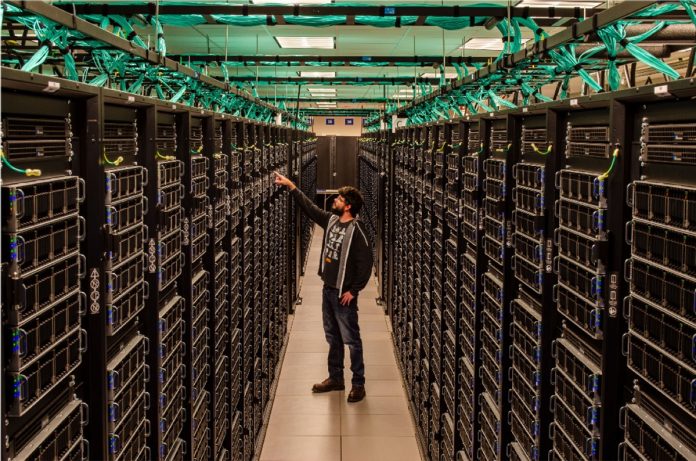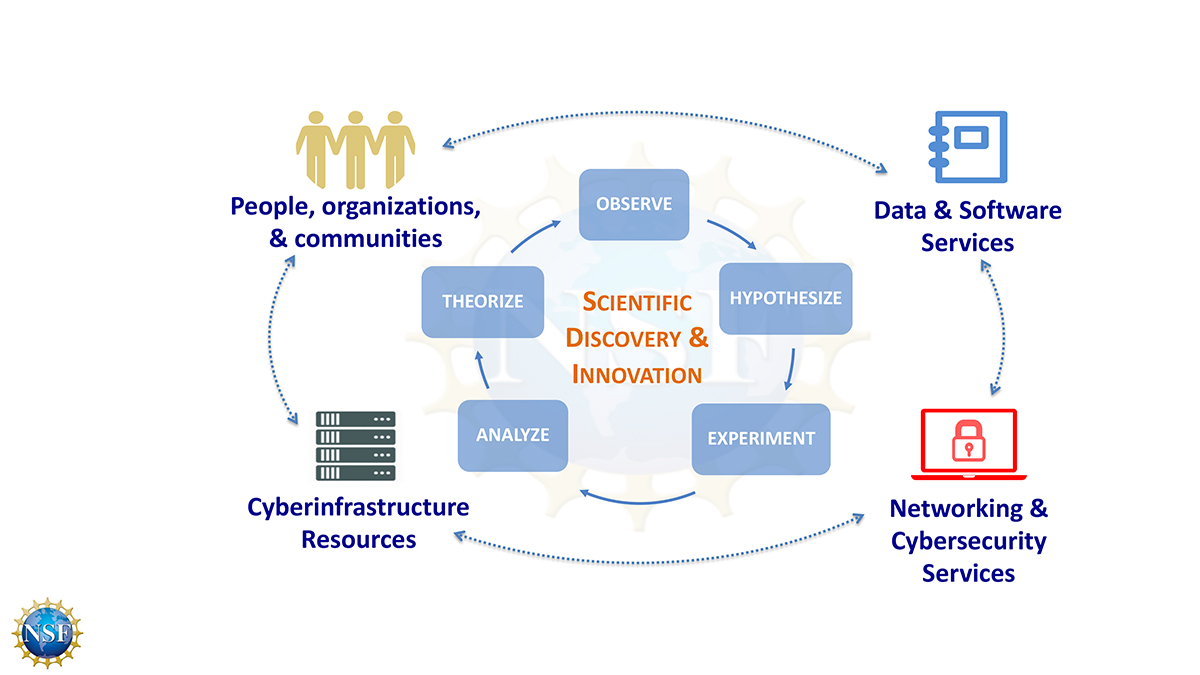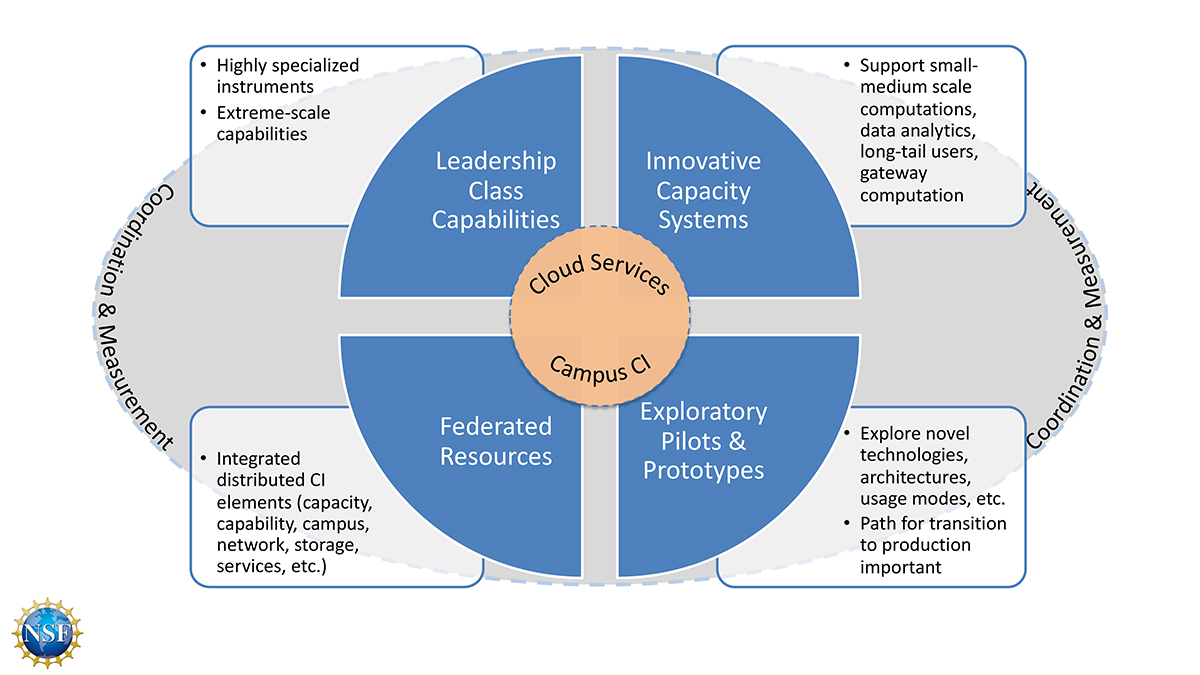
Here, four experts from the National Science Foundation reveal their thoughts about building an advanced computing ecosystem for 21st-century research and education
We are witnessing an inflection point in our Nation’s research and education enterprise: The unprecedented availability and scale of data and computation are transforming all fields of science and engineering (S&E) and the technology landscape enabling scientific and engineering discovery and innovation is evolving rapidly. Indeed, advanced computing systems and services are now integral to enabling advances across all fields – and ultimately ensuring the Nation’s continued leadership and competitiveness.
In support of evolving S&E drivers and leveraging a constantly-changing technology landscape, the Office of Advanced Cyberinfrastructure (OAC) within the National Science Foundation (NSF) provides broad access to an agile, integrated, robust, trustworthy and sustainable cyberinfrastructure (CI) ecosystem for the Nation’s researchers and educators.(1) NSF’s CI investments align with national priorities for future computing systems, as outlined in the National Strategic Computing Initiative (NSCI). (2) Central to NSF’s vision is a balanced ecosystem (as illustrated in Figure 2) that effectively supports a broad and diverse set of requirements, users and usage modes. It increasingly blends translational computational research and cyberinfrastructure, while integrating innovations from the private sector. Furthermore, it includes crosscutting coordination, allocation, measurement and user support services and is complemented by the other components of the CI ecosystem including software and data services, networking, cybersecurity and learning and workforce development.
Here, we describe some of the key pillars and the associated activities that OAC has been spearheading over the last year, in support of this ecosystem.

Leadership-class computing
So-called “leadership-class computing” constitutes highly specialised computation and data analytics instruments providing the extreme-scale capability to support S&E research and education that would simply not be possible otherwise. With support from NSF, the Texas Advanced Computing Center (TACC) at the University of Texas at Austin (UT Austin) recently launched the Frontera system. (3) This leadership-class computing system is the most powerful supercomputer ever deployed on a U.S. academic campus and will support some of the Nation’s most computationally challenging science applications. Frontera ranked fifth in the June 2019 edition of the Top500 supercomputers list – but the system is specifically designed for sustained performance across all kinds of S&E job classes. The system began accepting early S&E research users in May 2019 and will enable advances ranging from natural hazards modelling and energy research to genomics and astrophysics.

Advanced Computing Systems and Services (ACSS)
NSF’s Advanced Computing Systems and Services (ACSS) program supports innovative computing systems that explore novel approaches, architectures and delivery models, while at the same time serving as “production” platforms for the broad range of computation and data analytics needs of the S&E community. A key goal of these systems is to leverage federated and/or distributed resources, regional and/or campus supported resources and/or commercial cloud services.
In the last year, OAC has funded three such systems:
- Expanse: Computing without Boundaries: Cyberinfrastructure for the Long Tail of Science, located at the University of California-San Diego, provides increased capacity and performance for users of batch-oriented and science gateway computing; integration with the public cloud and the Open Science Grid is a key component.
- Bridges-2: Scalable Converged Computing, Data, and Analytics for Rapidly Evolving Science and Engineering Research, located at Carnegie-Mellon University, provides a high-capacity, large memory system targeting high-performance data-driven analytics with machine learning/deep learning/artificial intelligence applications.
- And Ookami, at the State University of New York at Stony Brook, is a prototype/testbed system that seeks to explore the Fujitsu A64fx processor with ultra-high memory bandwidth to better support memory-intensive applications. It’s also the first such system outside Japan that leverages this processor.
Cloud computing services
In addition to the innovative advanced computing systems and services described above, cloud computing services are playing an increasingly important role in supporting academic and research computing – and NSF has explored partnerships with commercial cloud computing providers in recent years to better integrate cloud computing services into the CI ecosystem.
For example, through NSF’s CloudAccess program, CloudBank,(5) is supporting a collaboration among the University of California-San Diego, the University of California-Berkeley and University of Washington, and is delivering a set of managed services, including education and training, to enhance access for the computer and information science and engineering research and education community to public clouds. NSF intends to assess this pilot and potentially scale it to other fields.
Similarly, in the E-CAS(6) project, the non-profit computer networking consortium Internet(2) is helping build partnerships with commercial cloud computing providers to support S&E applications that leverage new and more effective uses of cloud computing capabilities. In partnership with Amazon Web Services, Google Cloud Platform and Oracle Cloud,(7) Internet(2) is leading the S&E community in investigating the viability of commercial clouds for leading-edge computational S&E supporting a range of academic disciplines.
Conclusion
Twenty-first-century S&E research and education is being actively transformed by the increasing availability and scales of computation and data. The federally funded U.S. CI ecosystem has, thus, become a key catalyst for discovery and innovation, playing a critical role in ensuring the Nation’s leadership in S&E, economic competitiveness and national security. NSF plays a central role in realising this national CI ecosystem, providing advanced computing systems and services that are critical for enabling discoveries and driving innovation across all of S&E.
References
(1) “Transforming Science Through Cyberinfrastructure: NSF’s Blueprint for a National Cyberinfrastructure Ecosystem for Science and Engineering in the 21st Century,” https://www.nsf.gov/cise/oac/vision/blueprint-2019/
(2) “National Strategic Computing Initiative (NSCI),” https://www.nsf.gov/cise/nsci/
(3) Frontera, Texas Advanced Computing Center (TACC), https://fronteraweb.tacc.utexas.edu/
(4) Top500, https://www.top500.org/
(5) “CloudBank,” https://www.cloudbank.org
(6) “Exploring Clouds for Acceleration of Science,” https://www.internet2.edu/vision-initiatives/initiatives/exploring-clouds-acceleration-science/
(7) Note that other NSF programs have also included partnerships with Microsoft Azure and IBM, such as, for example, “Critical Techniques, Technologies and Methodologies for Advancing Foundations and Applications of Big Data Sciences and Engineering (BIGDATA),” https://www.nsf.gov/funding/pgm_summ.jsp?pims_id=504767










